Marketing Strategies
How COVID Has Shifted the Advertising World
Accelerated trends that brands and retailers must adopt in the age of COVID
Consumer behavior trends have shifted advertising models and caused advertisers of all sizes to rethink the type of campaigns they should run. As we continue to ride the compulsory state of isolation with varying “shelter-at-home” orders across the country, the channels, messaging, and KPI’s that advertisers rely on must continue to remain fluid.
The impact of COVID-19 will continue to ripple across the world long after the pandemic has slowed and many of the advertising adjustments that are being made now are likely to stick long into the future.
We have entered a new age, but by remaining nimble, brands will be able to meet the ever-changing needs of their audiences post-lockdown and beyond. Read on to learn more about the trends taking place and how advertising models are being transformed.
Flexible Supply & Fulfillment
COVID-19 presents many roadblocks concerning fulfillment. In response to the pandemic, many businesses have continued to deliver goods to their customers with innovative, community-driven solutions, including contactless delivery and curbside pickup.
A study from Marketing Week shows that pre-pandemic, the average consumer’s main shopping priorities were quality (48%), price (47%), and brand (24%). At present, people are mostly concerned with availability (49%), price (36%), and quality (34%).1
The crisis has tipped consumer priorities on their head. As lockdown eases, and the world slowly regains “normal function,” it’s likely that consumers will still value availability. Brands that continue to provide a mix of flexible supply and fulfillment options to meet the needs of consumers will win on the commercial battlefield.
Led by insightful location-based data, retailers will be able to offer customers a range of efficient fulfillment options tailored to their audience. Curbside “on the go” delivery and seamless buy online, pickup in-store (BOPIS) experiences offer consumers a perfect storm of convenience and flexibility.
Community
One of the silver linings of COVID-19 is that communities are rallying together in the face of adversity. From face mask manufacturing and contactless care package delivery to frontline worker support, businesses are placing their focus on serving the people in their respective locales.
77% of consumers expect brands to be useful during the COVID-19 pandemic.2 And, while there has been a huge shift towards brand values and transparency in recent years, it’s likely that there will be even greater emphasis on community outreach post-pandemic.
As a new chapter dawns, it’s vital that brands focus not only on the wider world but also on their local communities by leveraging location-based audiences to their advantage. By developing community-based campaigns and working with location-driven data to deliver personalized messaging at opportune times with the likes of push marketing and location-based ads, brands will boost awareness and loyalty as COVID-19 slows down.
The bottom line: Invest in being a pillar of the community and you will remain aligned with fresh consumer values post-pandemic. Consumer values have changed and by offering value and transparency, the likes of building up customer loyalty will be on your side.
Advertising Migration and Measurement
As a general rule of thumb, when consumer habits shift en masse, ad spend and mediums do too. Since the start of the pandemic, ad spend in the US has dropped 10% amid economic concerns.3 But, as online media consumption has risen in recent months, there is real value in online advertising.
“The current trend of online shopping will continue in the medium- to long-term, with e-commerce becoming an increasingly important channel within the marketing mix.”3 – Conny Braams, Chief Digital and Marketing Officer, Unilever
Even as the world begins to open up, the engrained desire for convenience and value spurred by COVID-19 will remain. This means that by utilizing digital advertising channels and delivering content at a time when consumers are likely to be most engaged, advertisers can encourage direct conversions or engagement, almost on the spot. In turn, this will offer an excellent return on ad spend (ROAS) – one of the most meaningful metrics for advertisers as shown below.4
Take online viewing, for instance. Pay-TV is now dwindling and CTV / OTT streaming services are seeing a rise in viewership. This shift towards online entertainment offers valuable opportunities for brands looking for reactive ways to drive sales while boosting brand awareness. If ad content runs right before an episode of a show relevant to a niche audience (one that appeals to an advertiser’s target demographic), it stands an excellent chance of driving website traffic and increasing overall conversion rate in the process.
By understanding the audience and their viewership patterns, marketers can then retarget those audiences across other devices and channels and drive them further down the purchase funnel.
As consumerism becomes increasingly remote, placing a focus on direct response marketing campaigns will yield sustainable results. For Gimbal, performance-based campaigns have been one of the biggest success drivers for clients over the last quarter with online conversions even exceeding goals.
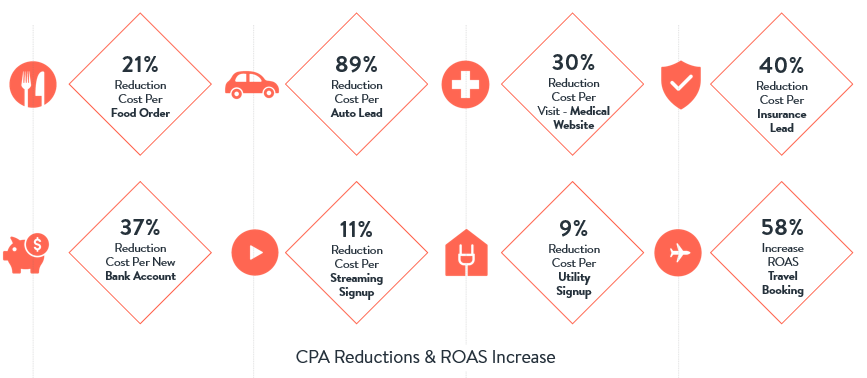
Niche or industry aside, as the world migrates further towards an online existence, aligning strategies, messaging, and the appropriate KPI’s will be key to measuring success.
An omnichannel marketing spotlight
Before the pandemic struck, many considered the U.S. to be overcrowded by brick-and-mortar stores, with more retail space per capita than any other nation on the planet.
Last year alone, 9,300 stores closed across the U.S.5—crushed by the rise in ecommerce adoption and competitors that embraced the possibilities of the digital age early. And, the economic uncertainty of the pandemic will force droves of other businesses to shut up shop.
But, by bridging the gap between the digital and physical world and marketing goods and services across a range of touchpoints, retailers stand a chance to thrive in the post-pandemic world.
The pandemic has even served to highlight and accelerate new omnichannel trends. Data shows that US click-and-collect ecommerce sales will leap 60.4% to $58.52 billion this year.6 The demand for convenient, frictionless commerce is greater than ever—a clear indication for the necessity of an omnichannel approach.
For example, offering a mobile app populated with engaging content that also offers the opportunity to purchase items and arrange delivery to a designated pickup point can help brands win on tomorrow’s commercial battlefield.
Taking a data-driven marketing approach and creating a cohesive marketing strategy across a network of channels and touchpoints will help brands connect with a wider and more engaged audience.
A new age of consumerism
In addition to getting to grips with the strategies and initiatives that are likely to shape the consumer world both during and after the pandemic, in order to truly connect with customers, understanding emerging shopping habits and priorities is crucial.
Here are some of the behaviors and priorities that are worth exploring:
- The uncertain nature of the pandemic has made many consumers more thoughtful and conscious about the products they buy. As such, placing focus on the essential value of your products or services will work in your favor.
- Research from Accenture shows that 88% of consumers are concerned about the pandemic’s impact on the economy.7 If your messaging is centered on your commitment to your customers and how you can help them – leaning on your sense of community – you’re likely to encourage better brand loyalty.
- COVID-19 has served to highlight the hyper-connective capabilities of the digital world. As consumers become more value-driven (both in terms of cost and what brands can do for them), emphasizing virtual shopping assistants and more extensive personal customer service offerings will prove essential to success.
- As consumers become more conscious and community-focused, local shopping will increase. Invest in your locale as well as your local marketing efforts, and you’re likely to see an excellent return on investment.
By leveraging the digital ad space with timely messaging across touchpoints marketers will stand a greater chance of connecting with valuable segments of their target audience.
“You can’t solve a problem on the same level that it was created. You have to rise above it to the next level.”-Albert Einstein
Things may never be the same again—and that isn’t all bad. While it may be “survival” for now, by changing the commercial outlook and staying in tune with the needs of consumers, marketers will prevail tomorrow and long into the future.
1 How Covid-19 Has Changed Shopper Behaviour. MarketingWeek. May 7, 2020
2 Communities Are Coming Together (at a Distance), and Brands Should Support That. AdWeek. April 3, 2020
3This is How COVID-19 is Affecting the Advertising Industry. World Economic Forum. June 8, 2020
4The State of Programmatic Advertising. Perfect Audience. May 2020
5Is Omnichannel Retail Brick-and-Mortar’s Saving Grace? eMarketerJune 29, 2020
6Frictionless Commerce 2020: How Coronavirus Is Accelerating Seamless Omnichannel Retail eMarketer. May 21, 2020
7COVID-19 will permanently change consumer behaviorAccenture. April 28, 2020
Marketing Strategies
5 of the Best Newsletter Examples
In the age of email marketing, virtually every B2B enterprise has its own newsletter.
For you, a newsletter performs a very important function. It’s the most efficient way (by far) to be sure you can maintain contact with your potential customers until they are ready to buy.
Use these steps and killer email newsletter examples to help you keep your subscribers up to date on anything you want them to know.
The Purpose of a Newsletter
The purpose of a newsletter is to keep those on your email list updated on anything that has to do with your business. For instance, you may send a newsletter with information about new products, updates on changes, testimonials and reviews, helpful resources, and other pertinent information.
Newsletters should not be used to hard-sell your products or services to your audience. They should be similar to an update from a helpful and interesting friend, rather than an intrusive salesperson.
Sending newsletters as a part of your email marketing strategy helps you to connect and engage with your customers on a more personal and meaningful level.
This can help you achieve your marketing goals since email marketing often provides your business with generous returns. In fact, research shows the big picture impact your email efforts can have on your business:
- Email marketing has the highest return on investment for small businesses.
- Nearly 80 percent of marketers say they’ve seen their email engagement increase over the last 12 months.
Simply put, the power of email marketing is hard to overstate.
How to Write a Newsletter
Writing a newsletter should be fairly simple with the large variety of email marketing tools that now have full libraries with newsletter email templates. Here are some easy steps you can take to start writing your first newsletter draft for your business:
1. Decide What You Want to Share.
Before you can write any information into your newsletter email, you must decide what message you’d like to send your subscribers.
For instance, you may include the following components:
- Newly published content such as blog posts and videos
- New product launches
- Discounts
- Other people’s content that you believe relates to your audience in a meaningful way
- Shorter form blog posts
- Progress your business has made with new projects
In many cases, businesses select a couple of different things to share in one newsletter, depending on the frequency of the newsletter they are sending.
For instance, if you have a monthly newsletter, then you may consider making it longer and more comprehensive. If your newsletter is daily, then you may select one specific topic to explore in your email content.
Once you decide what content will be the most beneficial to your list in your newsletter, you can begin drafting your newsletter.
2. Write a Draft First.
Start by writing your first draft as though you are writing to a specific person. This could be a specific customer or buyer persona you made up to represent your ideal subscriber, or it could be someone you may know.
When you write the email as though you are writing to a specific person, you make it more personalized and interesting to the recipient.
Don’t take too much time on your first draft; just flesh out all of your ideas and then trim it down or beef it up from there.
3. Review the Draft.
Now that you’ve written your first full newsletter draft, it is time to review it and make edits. You’ll want to make sure your newsletter sounds interesting and that it flows well.
You should also check for grammatical and spelling errors by reading the email out loud at least once or twice.
If you can’t read it out loud, then you can use a text-to-speech tool to catch these errors. Word has a tool that reads your text for you, or you can use tools like Natural Readers.
It may also be helpful to have a coworker or friend read the email to help you refine the email further.
Don’t forget to add images and links in the review stage!
4. Test Your Newsletter With a Portion of Your List.
You may want to consider testing your newsletter with a portion of your audience before you send it to your whole list. This helps you to see the open rates the email gets and allows you to gauge whether or not the content in the newsletter is working ok.
5. Schedule a Send Date.
Once you determine that everything is as good as it can be with your newsletter, you can schedule a send date for it. Be sure to check your inbox for emails from the users you sent the test batch to.
If they mention that links or images don’t show up correctly, fix the issues before you send the newsletter to your entire email list.
15 Newsletter Tips You Can Use Next Month
If you’re looking for newsletter tips, then odds are good you’ve noticed the problem with the idea of a corporate newsletter: It’s valuable for you, but it’s not always obvious how to make it equally enticing to the audience you plan to serve.
Let’s look at email newsletter tips that help you to provide value for your subscribers and increase engagement.
1. Put Your Audience First.
Your audience is the most important consideration for your email newsletter. Work to segment your audience from the beginning so they only get relevant, high-impact messages. A handful of on-target messages do more work than a daily email that’s hit or miss.
Consider what your subscribers have clicked on and engaged with in the past and segment them by their interests. Test different newsletter styles and headlines for each segment to help you improve open rates.
2. Include One CTA at a Time.
If you have a CTA in your newsletter, you are already ahead of the game.
But make sure you don’t overload your reader with endless CTAs. Just like your landing pages, your emails should generally have only one CTA.
There are two exceptions to this rule: A newsletter that aggregates your top content (where any click to your site is a win) or newsletters from retail brands. Specific, targeted offers should take the spotlight in most emails.
3. Optimize for the Mobile Devices.
In the last few years, most emails have been opened by mobile rather than on desktop. This is why it’s essential to ensure your email is optimized for mobile display and navigation.
You don’t want to miss out on providing value to a large section of your email recipients because you forgot to make sure your newsletter emails were mobile friendly before sending them off.
4. Be Consistent About Email.
Tell your leads what frequency of emails to expect as soon as they’re on your signup form. Once they actually do sign up, be consistent in delivering what they expect.
If you fade away, your campaign will lose impact. And if you overwhelm them with messages, they’ll run away.
5. Use Email to Amplify Content.
If you have some recent content that you’re especially proud of, an email campaign is a terrific way to get more eyes on it. Blog posts, videos, and infographics are especially popular for email recipients. Don’t be afraid to show off content just because some subscribers might have seen it.
Emails are also easy to forward, and some of your subscribers may be willing to share your content with others who they think may be interested. This can help you increase your website traffic.
6. Nail the Subject Line.
Your email subject line is like the headline of your blog posts: It determines whether people will be intrigued enough to read the first few lines.
If you want to maximize your ROI from email, then it’s a sound idea to start split testing email subject lines as soon as you can.
Speaking of maximizing ROI…
7. Hook Email into Your Analytics.
Analytics won’t make any one particular email better, but they can help you kick start a general trend of continuous improvement.
Email data gives you insight on what subject lines were most effective, what links got clicked, and what days and times are the best for engagement. Use it!
8. Have Clear Email Onboarding.
An email onboarding sequence is the perfect way to acclimate your new subscribers to being contacted by you so your first messages won’t spook them.
It also serves as customer education, helping you make sure leads will get the most value from your website.
9. Vary Your Content Styles.
Email newsletter tips should point out this overlooked fact: A “newsletter” doesn’t have to be the same thing every time.
With different content styles, you can key into audience preferences. For example, you can try “best of” lists from your blog, curated content, case studies, and more.
10. Use Seamless Social Integration.
When marketers look for “engagement,” they’re usually thinking of likes, shares, and clicks. If you want emails to drive these actions in the right direction, then make them easier.
Have simple social share buttons on your messages so recipients can forward them to their networks fast.
11. Ask For (and Facilitate) Comments.
People love to sound off on topics of genuine interest to them. Call for comments, questions, and suggestions and you just might get them.
A comment system that creates a clear link between your site users and their social identity will encourage them to comment more.
One thing stands out about the best email newsletter tips: If you’ve been following the inbound way of doing business, then you already have a strong idea of what might work.
Inbound marketers truly understand the impact of delivering value upfront and educating their target audience. Your newsletter is an essential component of inbound marketing.
12. Identify the Sender.
Most people don’t want to open emails from people or businesses that aren’t identified no matter how good the subject line and preview text may be.
There are a lot of spammy emails out there, and you want to make sure your subscriber knows that you aren’t spamming them or, even worse, sending them a virus.
Most email marketing software allows you to set the sender name within the content. For example, HubSpot Marketing Hub offers personalization tokens you can use in various forms of content, including emails.
A popular format that is used today is as follows: [firstname] at/from [company name].
13. Customize the Preview Text.
Customized preview text enhances the headline of your email header. According to data collected by Litmus, about 24 percent of people consider the preview text before they decide whether or not they will open an email.
The preview text presents you with an opportunity to increase your newsletter email open rate. Some things that you can do with preview text includes:
- Add a call to action.
- Personalize it using the recipient’s name.
- Add a simple description of what’s in the email.
Remember to avoid leaving the default text because it is uninviting to your recipients.
14. Select the Right Format.
Format for an email newsletter is everything! Make sure your format is simple and easy to read so that your recipients can absorb and digest the information with ease.
Use templates with a clean and sleek design and insert your content and links appropriately to make sure the format still looks good on mobile and desktop computers.
15. Test. Test, Test.
You won’t know if your newsletters are truly effective until you test them. You must test what works for your business and for your audience. You can:
- Conduct split tests.
- Pre-test content by sharing posts on social media with different headlines.
- Try different headlines within the newsletter.
- Vary your CTAs.
With continuous testing, you can build a great newsletter for your business.
5 of the Best Newsletter Examples
To help you develop your newsletter further and get inspired, here are five great real newsletter examples from businesses:
Trello
The user-friendly web-based project management tool Trello has a newsletter from “Taco” that is sent to users about once a week.
It is a simple and direct newsletter with helpful tips and tricks on how to work Trello better or manage projects more efficiently. Essentially, it is a roundup of Trello’s best content.
The colors and images they use are eye-catching. Plus, they add a nice touch by assigning Taco, Trello’s adorable dog mascot, as the email sender.
Sendinblue
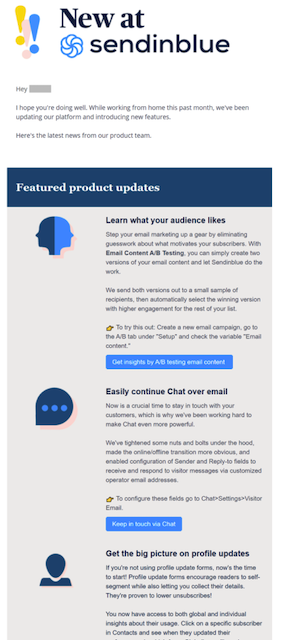
Sendinblue is a digital marketing agency that serves small and medium-sized businesses. Their newsletters provide subscribers with product updates and helpful resources.
They make sure their audience is educated and informed about the company and its offers with their simple newsletters. They also include several CTAs to encourage their readers to find out more.
The Nature Conservancy
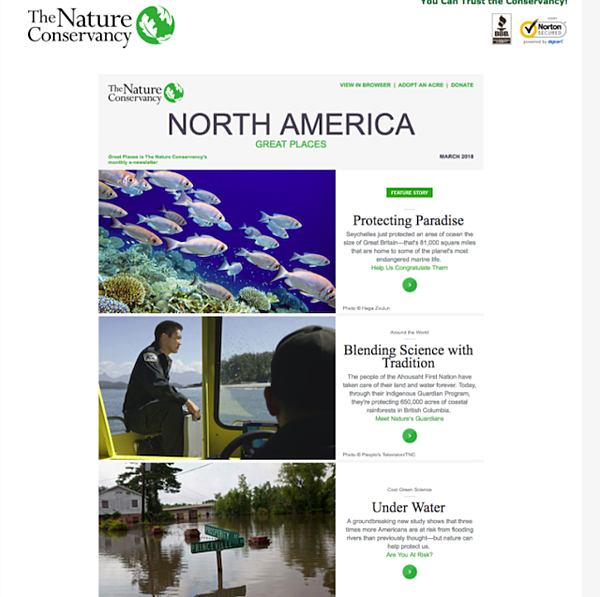
The Nature Conservancy sends out a monthly newsletter called “Great Places.” Other nonprofits typically have similar newsletters that relate to their mission.
This newsletter ensures contributors that progress is being made within the organization to make a difference.
The newsletter also includes several pictures, CTAs, and links to social media channels. Social media is a touchpoint for readers who want to know more about the organization’s story and efforts, and the CTAs take readers to a place where they can donate money to help.
Robinhood

Robinhood, a popular investing app, sends newsletters to their subscribers every day. In their newsletter, called “Robinhood Snacks,” they highlight key financial and stock information from the day prior.
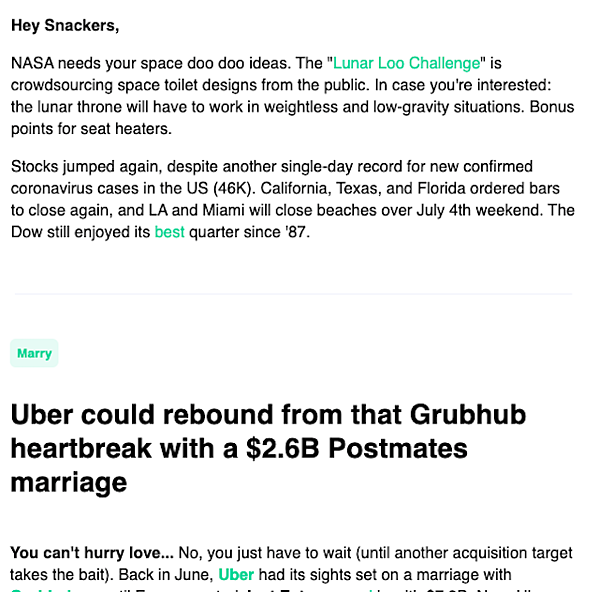
They break each section down into small paragraphs and bullet points to make it easy to read. They also include an image and links to other content that users may click on if they would like more information.
Statista
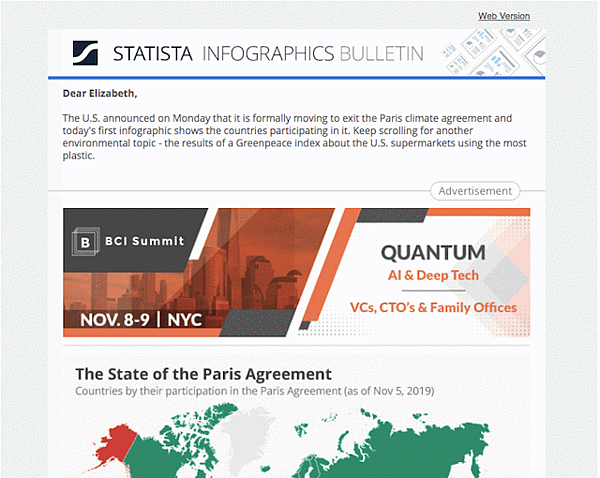
Statista is a data platform that reflects important numbers pertinent to various businesses. It has a great newsletter that shows several visually interesting infographics with business data.
They take a unique approach with bright images that make business data fun to look at and interpret with their newsletters.
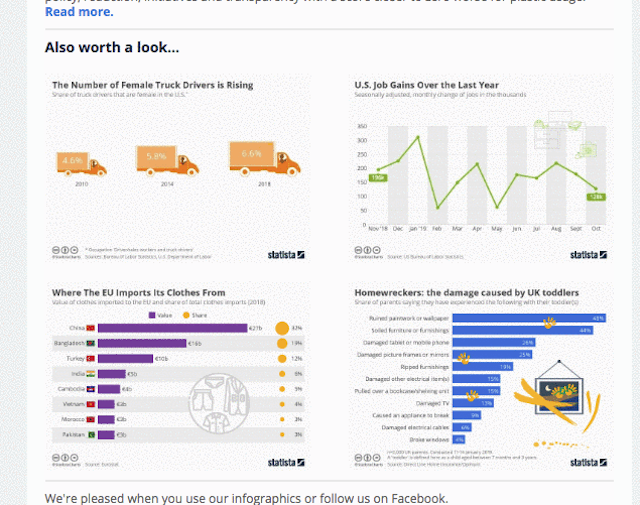
The secret is to take your existing content – which should be useful, informative, and helpful for your unique readers – and break down the best of what you offer into bite-sized chunks.
That will leave them wanting more … and, ultimately, spending more time actively engaged with your brand. Stick with it, and you’ll soon see the difference in user activity. Email really works!
Marketing Strategies
Desktop, Mobile, or Voice? (D) All of the Above — Best of Whiteboard Friday
Posted by Dr-Pete
Needless to say, we’re facing more and more complexity in our everyday work, and the answers to our questions are about as clear as mud. In the wake of the 2018 mobile-first index, and since more searchers are home and not on-the-go, we’re left wondering where to focus our optimization efforts. Is desktop the most important? Is mobile? What about the voice phenomenon that’s now become part of our day-to-day lives?
As with most things, the most important factor is to consider your audience. People aren’t siloed to a single device — your optimization strategy shouldn’t be, either. In this informative Whiteboard Friday, Dr. Pete soothes our fears about a multi-platform world and highlights the necessity of optimizing for a journey rather than a touchpoint.
Click on the whiteboard image above to open a high-resolution version in a new tab!
Video Transcription
Hey, everybody. It’s Dr. Pete here from Moz. I am the Marketing Scientist here, and I flew in from Chicago just for you fine people to talk about something that I think is worrying us a little bit, especially with the rollout of the mobile index recently, and that is the question of: Should we be optimizing for desktop, for mobile, or for voice? I think the answer is (d) All of the above. I know that might sound a little scary, and you’re wondering how you do any of these. So I want to talk to you about some of what’s going on, some of our misconceptions around mobile and voice, and some of the ways that maybe this is a little easier than you think, at least to get started.
The mistakes we make
So, first of all, I think we make a couple of mistakes. When we’re talking about mobile for the last few years, we tend to go in and we look at our analytics and we do this. These are made up. The green numbers are made up or the blue ones. We say, “Okay, about 90% of my traffic is coming from desktop, about 10% is coming from mobile, and nothing is coming from voice. So I’m just going to keep focusing on desktop and not worry about these other two experiences, and I’ll be fine.” There are two problems with this:
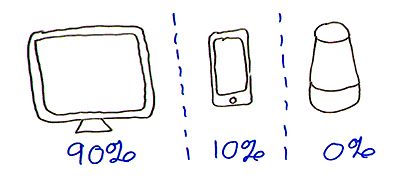
Self-fulfilling prophecy
One is that these numbers are kind of a self-fulfilling prophecy. They might not be coming to your mobile site. You might not be getting those mobile visitors because your mobile experience is terrible. People come to it and it’s lousy, and they don’t come back. In the case of voice, we might just not be getting that data yet. We have very little data. So this isn’t telling us anything. All this may be telling us is that we’re doing a really bad job on mobile and people have given up. We’ve seen that with Moz in the past. We didn’t adopt to mobile as fast as maybe we should have. We saw that in the numbers, and we argued about it because we said, “You know what? This doesn’t really tell us what the opportunity is or what our customers or users want. It’s just telling us what we’re doing well or badly right now, and it becomes a self-fulfilling prophecy.”
Audiences
The other mistake I think we make is the idea that these are three separate audiences. There are people who come to our site on desktop, people who come to our site on mobile, people who come to our site on voice, and these are three distinct groups of people. I think that’s incredibly wrong, and that leads to some very bad ideas and some bad tactical decisions and some bad choices.
So I want to share a couple of stats. There was a study Google did called The Multiscreen World, and this was almost six years ago, 2012. They found six years ago that 65% of searchers started a search on their smartphones. Two-thirds of searchers started on smartphones six years ago. Sixty percent of those searches were continued on a desktop or laptop. Again, this has been six years, so we know the adoption rate of mobile has increased. So these are not people who only use desktop or who only use mobile. These are people on a journey of search that move between devices, and I think in the real world it looks more something like this right now.
Another stat from the series was that 88% of people said that they used their smartphone and their TV at the same time. This isn’t shocking to you. You sit in front of the TV with your phone and you sit in front of the TV with your laptop. You might sit in front of the TV with a smartwatch. These devices are being used at the same time, and we’re doing more searches and we’re using more devices. So one of these things isn’t replacing the other.
The cross-device journey

So a journey could look something like this. You’re watching TV. You see an ad and you hear about something. You see a video you like. You go to your phone while you’re watching it, and you do a search on that to get more information. Then later on, you go to your laptop and you do a bit of research, and you want that bigger screen to see what’s going on. Then at the office the next day, you’re like, “Oh, I’ll pull up that bookmark. I wanted to check something on my desktop where I have more bandwidth or something.” You’re like, “Oh, maybe I better not buy that at work. I don’t want to get in trouble. So I’m going to home and go back to my laptop and make that purchase.” So this purchase and this transaction, this is one visitor on this chain, and I think we do this a lot right now, and that’s only going to increase, where we operate between devices and this journey happens across devices.
So the challenge I would make to you is if you’re looking at this and you’re saying, “Only so many percent of our users are on mobile. Our mobile experience doesn’t matter that much. It’s not that important. We can just live with the desktop people. That’s enough. We’ll make enough money.” If they’re really on this journey and they’re not segmented like this, and this chain, you break it, what happens? You lose that person completely, and that was a person who also used desktop. So that person might be someone who you bucketed in your 90%, but they never really got to the device of choice and they never got to the transaction, because by having a lousy mobile experience, you’ve broken the chain. So I want you to be aware of that, that this is the cross-device journey and not these segmented ideas.
Future touchpoints

This is going to get worse. This is going to get scarier for us. So look at the future. We’re going to be sitting in our car and we’re going to be listening — I still listen to CDs in the car, I know it’s kind of sad — but you’re going to be listening to satellite radio or your Wi-Fi or whatever you have coming in, and let’s say you hear a podcast or you hear an author and you go, “Oh, that person sounds interesting. I want to learn more about them.” You tell your smartwatch, “Save this search. Tell me something about this author. Give me their books.” Then you go home and you go on Google Home and you pull up that search, and it says, “Oh, you know what? I’ve got a video. I can’t play that because obviously I’m a voice search device, but I can send that to Chromecast on your TV.” So you send that to your TV, and you watch that. While you’re watching the TV, you’ve got your phone out and you’re saying, “Oh, I’d kind of like to buy that.” You go to Amazon and you make that transaction.
So it took this entire chain of devices. Again now, what about the voice part of this chain? That might not seem important to you right now, but if you break the chain there, this whole transaction is gone. So I think the danger is by neglecting pieces of this and not seeing that this is a journey that happens across devices, we’re potentially putting ourselves at much higher risk than we think.
On the plus side
I also want to look at sort of the positive side of this. All of these devices are touchpoints in the journey, and they give us credibility. We found something interesting at Moz a few years ago, which was that our sale as a SaaS product on average took about three touchpoints. People didn’t just hit the Moz homepage, do a free trial, and then buy it. They might see a Whiteboard Friday. They might read our Beginner’s Guide. They might go to the blog. They might participate in the community. If they hit us with three touchpoints, they were much more likely to convert.
So I think the great thing about this journey is that if you’re on all these touchpoints, even though to you that might seem like one search, it lends you credibility. You were there when they ran the search on that device. You were there when they tried to repeat that search on voice. The information was in that video. You’re there on that mobile search. You’re there on that desktop search. The more times they see you in that chain, the more that you seem like a credible source. So I think this can actually be good for us.
The SEO challenge
So I think the challenge is, “Well, I can’t go out and hire a voice team and a mobile team and do a design for all of these things. I don’t want to build a voice app. I don’t have the budget. I don’t have the buy-in.” That’s fine.
One thing I think is really great right now and that we’re encouraging people to experiment with, we’ve talked a lot about featured snippets. We’ve talked about these answer boxes that give you an organic result. One of the things Google is trying to do with this is they realize that they need to use their same core engine, their same core competency across all devices. So the engine that powers search, they want that to run on a TV. They want that to run on a laptop, on a desktop, on a phone, on a watch, on Goggle Home. They don’t want to write algorithms for all of these things.
So Google thinks of their entire world in terms of cards. You may not see that on desktop, but everything on desktop is a card. This answer box is a card. That’s more obvious. It’s got that outline. Every organic result, every ad, every knowledge panel, every news story is a card. What that allows Google to do, and will allow them to do going forward, is to mix and match and put as many pieces of information as it makes sense for any given device. So for desktop, that might be a whole bunch. For mobile, that’s going to be a vertical column. It might be less. But for a watch or a Google Glass, or whatever comes after that, or voice, you’re probably only going to get one card.
But one great thing right now, from an SEO perspective, is these featured snippets, these questions and answers, they fit on that big screen. We call it result number zero on desktop because you’ve got that box, and you’ve got a bunch of stuff underneath it. But that box is very prominent. On mobile, that same question and answer take up a lot more screen space. So they’re still a SERP, but that’s very dominant, and then there’s some stuff underneath. On voice, that same question and answer pairing is all you get, and we’re seeing that a lot of the answers on voice, unless they’re specialty like recipes or weather or things like that, have this question and answer format, and those are also being driven by featured snippets.
So the good news I think, and will hopefully stay good news going forward, is that because Google wants all these devices to run off that same core engine, the things you do to rank well for desktop and to be useful for desktop users are also going to help you rank on mobile. They’re going to help you rank on voice, and they’re going to help you rank across all these devices. So I want you to be aware of this. I want you to try and not to break that chain. But I think the things we’re already good at will actually help us going forward in the future, and I’d highly encourage you to experiment with featured snippets to see how questions and answers appear on mobile and to see how they appear on Google Home, and to know that there’s going to be an evolution where all of these devices benefit somewhat from the kind of optimization techniques that we’re already good at hopefully.
Encourage the journey chain
So I also want to say that when you optimize for answers, the best answers leave searchers wanting more. So what you want to do is actually encourage this chain, encourage people to do more research, give them rich content, give them the kinds of things that draw them back to your site, that build credibility, because this chain is actually good news for us in a way. This can help us make a purchase. If we’re credible on these devices, if we have a decent mobile experience, if we come up on voice, that’s going to help us really kind of build our brand and be a positive thing for us if we work on it.
So I’d like you to tell me, what are your fears right now? I think we’re a little scared of the mobile index. What are you worried about with voice? What are you worried about with IoT? Are you concerned that we’re going to have to rank on our refrigerators, and what does that mean? So it’s getting into science fiction territory, but I’d love to talk about it more. I will see you in the comment section.
Video transcription by Speechpad.com
To help us serve you better, please consider taking the 2020 Moz Blog Reader Survey, which asks about who you are, what challenges you face, and what you’d like to see more of on the Moz Blog.
Sign up for The Moz Top 10, a semimonthly mailer updating you on the top ten hottest pieces of SEO news, tips, and rad links uncovered by the Moz team. Think of it as your exclusive digest of stuff you don’t have time to hunt down but want to read!
Marketing Strategies
How to Use Instagram Insights (in 9 Easy Steps)
It’s no secret that we love data.
Data helps you understand your audience. It tells you how they do things, what they prefer, and who they are.
And when it comes to social media, our love for data doesn’t fade.
That’s why we love analytics and insights. They help you measure the impact of your marketing efforts across different channels to see if there’s something you need to do differently — like target a different audience, post at a certain time of day, or experiment with a new content format.
Instagram Insights are no exception. Here are the analytics on this channel that marketers need to know and understand — and how to use them.
To use Instagram Insights, you must first have a business profile.
If you’re already using a personal account, you can switch to a business profile. In order to have a Business Account, you must also have a Facebook Page for your brand. Instagram will give you the option to create a new one during this process if you don’t already have one. Here’s how to convert your account in a few simple steps.
Once your set up as a Business Account, you can begin to use Instagram Insights. Here’s how to get started.
1. Click the insights icon.
To view insights into your overall Instagram account, start by visiting your profile. Then, at the top, click the icon of a bar chart, which will take you to your overall insights.
From there, you’ll see some general information about people are engaging with your profile, like how many followers you gained or lost in the past week.
Next, we’ll get into the more specific profile insights you can explore.
2. View your impressions and reach.
This insight represents how many times your ads appeared on users’ screens. Reach reflects the number of unique users that have seen any of your Instagram posts.
3. Determine website clicks.
This insight reflects the number of times any links you’ve included in your business profile have been clicked.
4. Track profile visits and followers.
Profile visits reflects the number of times your profile has been viewed. Followers reflect how many followers you’ve gained or lost over the past week, as well as the average times of day when your followers are using Instagram — data that can be highly beneficial when planning posts. To view insights for a specific Instagram post, start by visiting your profile. Tap on the post you’d like to look into, then click “View Insights” below the image.
5. Click view insights below a post for specifics.
You may have also promoted a certain post — if that’s the case, an arrow icon that looks like this will appear:

For these posts, you can either view insights on the original version of the post, or specific ones from its promotion. For the latter, tap “Promotion.”
Next, we’ll get into the more specific post insights you can explore.
6. View your posts likes, comments, and saves.
Likes speaks for itself, and reflects the number of users who liked your post. As with likes, comments reflects the number of comments left on your post. Saves highlights the number of unique users or accounts who saved your post, or clicked the bookmark-like icon that appeared below it in their feeds.
7. Learn which actions were taken on your post.
These insights indicate the number of actions that users took on your profile as a result of seeing your post — things like visiting your profile, then taking an action like clicking on your website link or following you.
Source: Instagram
8. Use Discover to see where your post showed up in feeds.
As the name might suggest, these insights indicate where your post was seen — or discovered — the most, including how many accounts weren’t already following you when they first saw the post.
This section includes metrics on Impressions, which reflect the number of times your post was discovered from a particular place within Instagram, like the user’s home feed, a search, your profile, a location tag, or a hashtag.
Source: Instagram
Discovery insights also include data on a post’s reach — which reflects the number of unique accounts that saw your post.
9. View Instagram Story Insights
Finally, Instagram users with a business profile are able to view insights into their ephemeral Stories. Instagram does not, however, offer such analytics for live videos.
To view your Story insights, start by visiting your profile. Then, at the top, tap the icon of the bar chart, which will take you to your overall profile insights.

Scroll down to the Stories section, and you’ll be able to see insights for older stories, as well as any that have not yet expired.
Next, we’ll get into the more specific Story insights you can explore.
Impressions
This insight represents how many times your Story was seen.
When viewing these insights, keep in mind that you’re able to add multiple images or videos to your Story. When you do this, every piece of visual content in your Story is counted as a single photo or video in your post.
Let’s say you add six photos to your Story. Whether someone only views one or views all six, Instagram only counts your entire Story having received one impression.
The same goes for Story content that has been viewed by a single user more than once. Instagram still only counts that interaction as the entire Story having received one impression.
Reach
This insight reflects the number of unique users that have seen your Story.
Taps Forward
This insight reflects the number of times a user taps your Story photo or video to skip to the next piece of media.
Taps Back
This insight reflects the number of time a user taps your Story photo or video to go back to the previous piece of media.
Replies
This insight reflects the number of times users send messages through the “Send Message” text box on your Story.

Swipe Aways
This insight reflects the number of times users swipe to skip to the next account’s Story — not to be mistaken for “tap forward,” which reflects users skipping ahead to your next piece of Story media.
Exits
This insight reflects the number of times a user leaves the Stories section entirely to return to the home feed.
Now that you know how to measure the effectiveness of your Instagram strategy using Insights, you can analyze that data and determine what’s working for your audience. From there, creating content that gets a ton of engagement will be a lot easier as you consider those benchmarks.
Editor’s Note: This post was originally published in January 2018 but has been updated for comprehensiveness.
-
 Business4 weeks ago
Business4 weeks agoBernice King, Ava DuVernay reflect on the legacy of John Lewis
-
World News3 weeks ago
Heavy rain threatens flood-weary Japan, Korean Peninsula
-
 Technology3 weeks ago
Technology3 weeks agoEverything New On Netflix This Weekend: July 25, 2020
-
Finance3 months ago
Will Equal Weighted Index Funds Outperform Their Benchmark Indexes?
-
Marketing Strategies7 months ago
Top 20 Workers’ Compensation Law Blogs & Websites To Follow in 2020
-
 World News7 months ago
World News7 months agoThe West Blames the Wuhan Coronavirus on China’s Love of Eating Wild Animals. The Truth Is More Complex
-
Economy10 months ago
Newsletter: Jobs, Consumers and Wages
-
 Finance8 months ago
Finance8 months ago$95 Grocery Budget + Weekly Menu Plan for 8

